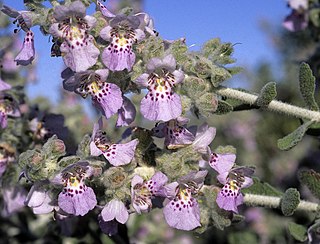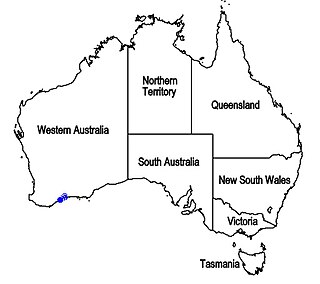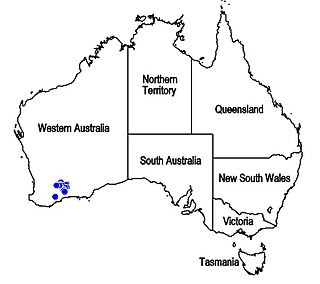
Pityrodia is a genus of flowering plants in the mint family, Lamiaceae and is endemic to Australia, most species occurring in Western Australia, a few in the Northern Territory and one in Queensland. Plants in this genus are shrubs with five petals joined to form a tube-shaped flower with four stamens of unequal lengths.

Dasymalla is a genus of five species of flowering plants in the mint family, Lamiaceae and is endemic to Western Australia. Plants in this genus are woolly shrubs with five petals joined to form a tube-shaped flower with four stamens of unequal lengths. These species are similar to those in the genus Pityrodia except that the fruit does not release its seeds when mature.
Dasymalla axillaris, commonly known as native foxglove or woolly foxglove, is a flowering plant in the mint family Lamiaceae and is endemic to Western Australia. It is a small, diffuse shrub with its branches, leaves and some of its flower parts densely covered with white, woolly hairs. The flowers are a shade of red and tube-shaped with the stamens and style extending beyond the end of the five petals.

Quoya atriplicina, commonly known as saltbush foxglove, is a flowering plant in the mint family Lamiaceae and is endemic to Western Australia. It is a bushy shrub with its branches and leaves densely covered with a layer of hairs, giving them a greyish appearance. The leaves are broad-elliptic to almost circular in shape and the tube-shaped flowers are pink with purple spots inside.

Dasymalla terminalis, commonly known as native foxglove, is a flowering plant in the mint family Lamiaceae and is endemic to the south-west of Western Australia. It is a shrub with its branches, leaves and some of its flower parts densely covered with white, woolly hairs. The leaves are thick and soft and the flowers are tube-shaped, pale to deep pinkish-purple or claret red.

Quoya oldfieldii, commonly known as Oldfield's foxglove, is a flowering plant in the mint family Lamiaceae and is endemic to the south-west of Western Australia. It is an erect shrub with its branches and leaves densely covered with a layer of brownish hairs. The leaves are egg-shaped and the tube-shaped flowers are pink with purple spots inside.
Dasymalla chorisepala is a flowering plant in the mint family Lamiaceae and is endemic to Western Australia and the Northern Territory. It is a small shrub with its branches and leaves densely covered with hairs. The leaves are stalkless, egg-shaped and covered with yellowish hairs while the flowers are small, tube-shaped and white.
Dasymalla glutinosa is a flowering plant in the mint family Lamiaceae and is endemic to Western Australia. It is a spreading, sticky shrub with glabrous branches, egg-shaped, stalkless leaves and small, white or cream-coloured, tube-shaped flowers.
Dasymalla teckiana is a flowering plant in the mint family Lamiaceae and is endemic to Western Australia. It is a small, openly branched, sticky shrub with mauve and white, bugle-shaped flowers.

Pityrodia loricata is a flowering plant in the mint family Lamiaceae and is endemic to Australia. It is a dense, greyish, multi-stemmed shrub with whorled leaves, prominent sepals and pale, pinkish-white flowers. It is common in Western Australia and the Northern Territory and there is a single record from South Australia.

Quoya dilatata is a flowering plant in the mint family Lamiaceae and is endemic to Western Australia. It is a low, spreading shrub with its branches and leaves densely covered with a layer of white, woolly hairs. The leaves are wrinkled or crinkly and the tube-shaped flowers are orange-red and hairy on the outside.

Pityrodia canaliculata is a flowering plant in the mint family Lamiaceae and is endemic to a small area in Western Australia. It is a many-branched shrub with all its parts, except the petals covered with small, circular scales. The tube-shaped flowers are white with reddish spots inside.

Pityrodia chrysocalyx is a flowering plant in the mint family Lamiaceae and is endemic to the south-west of Western Australia. It is an erect, bushy shrub with small, glossy leaves, and flowers with white petals and a golden-yellow calyx.
Muniria megalophylla is a flowering plant in the mint family Lamiaceae and is endemic to Arnhem Land in the Northern Territory. It is a shrub with its branches and leaves densely covered with a layer of short, greyish, branched hairs and small groups of reddish-pink flowers near the ends of the branches.

Hemiphora exserta is a flowering plant in the mint family Lamiaceae and is endemic to the south-west of Western Australia. It is a sprawling shrub with its branches densely covered with white, woolly hairs. Its leaves are rough and wrinkled and the flowers are deep pink or dark red, curved and tube-shaped with spreading petal lobes on the end.

Hemiphora lanata is a flowering plant in the mint family Lamiaceae and is endemic to the south-west of Western Australia. It is a sprawling shrub with its branches and leaves densely covered with white, woolly hairs and with deep pink or dark red, curved, tube-shaped flowers with spreading petal lobes on the end. It is similar to Hemiphora exserta except for its cottony leaf-covering and its longer stamens.
Quoya paniculata is a flowering plant in the mint family Lamiaceae and is endemic to Western Australia. It is a shrub with its branches and leaves densely covered with a layer of woolly hairs. The flowers are usually arranged in small groups surrounded by woolly hairs and are bell-shaped and deep purple or deep lilac. It is similar to Dasymalla axillaris and D. terminalis but is distinguished from them by its wedge-shaped leaf ends and more northerly distribution.

Quoya verbascina, commonly known as golden bush, is a flowering plant in the mint family Lamiaceae and is endemic to Western Australia. It is an erect shrub with its branches and leaves densely covered with woolly hairs. The leaves are often oblong but very variable in shape and the flowers are pinkish-white with pink spots inside and are surrounded by yellow woolly sepals.

Pityrodia lanuginosa is a flowering plant in the mint family Lamiaceae and is endemic to Arnhem Land in the Northern Territory. It is a woolly, spreading shrub with its leaves arranged in four rows and off-white, bell-like flowers with dark purple streaks.

Pityrodia obliqua is a flowering plant in the mint family Lamiaceae and is endemic to the Kimberley region of Western Australia. It is an erect shrub with hairy stems, wrinkled, egg-shaped leaves and pink, bell-like flowers with purple streaks inside.
















